八年级上册教案设计Unit 3 Our HobbiesTopic 1 What’s your hobbySection A
- 格式:doc
- 大小:80.50 KB
- 文档页数:7
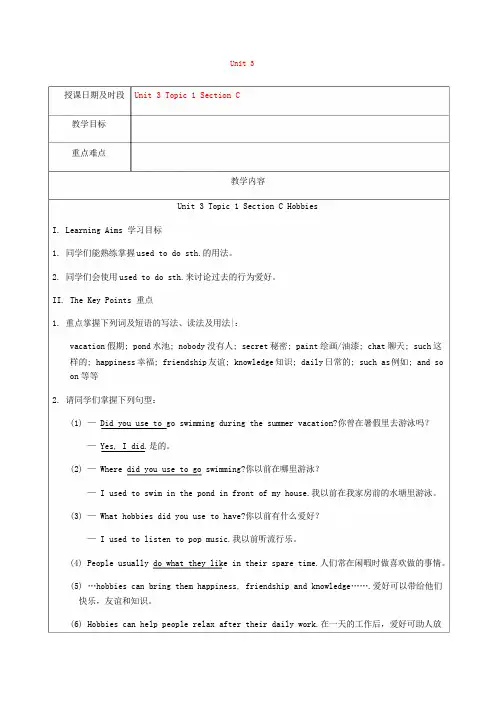
Unit3授课日期及时段Unit3Topic1Section C教学目标重点难点教学内容Unit3Topic1Section C HobbiesI.Learning Aims学习目标1.同学们能熟练掌握used to do sth.的用法。
2.同学们会使用used to do sth.来讨论过去的行为爱好。
II.The Key Points重点1.重点掌握下列词及短语的写法、读法及用法|:vacation假期;pond水池;nobody没有人;secret秘密;paint绘画/油漆;chat聊天;such这样的;happiness幸福;friendship友谊;knowledge知识;daily日常的;such as例如;and so on等等2.请同学们掌握下列句型:(1)—Did you use to go swimming during the summer vacation?你曾在暑假里去游泳吗?—Yes,I did.是的。
(2)—Where did you use to go swimming?你以前在哪里游泳?—I used to swim in the pond in front of my house.我以前在我家房前的水塘里游泳。
(3)—What hobbies did you use to have?你以前有什么爱好?—I used to listen to pop music.我以前听流行乐。
(4)People usually do what they like in their spare time.人们常在闲暇时做喜欢做的事情。
(5)…hobbies can bring them happiness,friendship and knowledge…….爱好可以带给他们快乐,友谊和知识。
(6)Hobbies can help people relax after their daily work.在一天的工作后,爱好可助人放松。
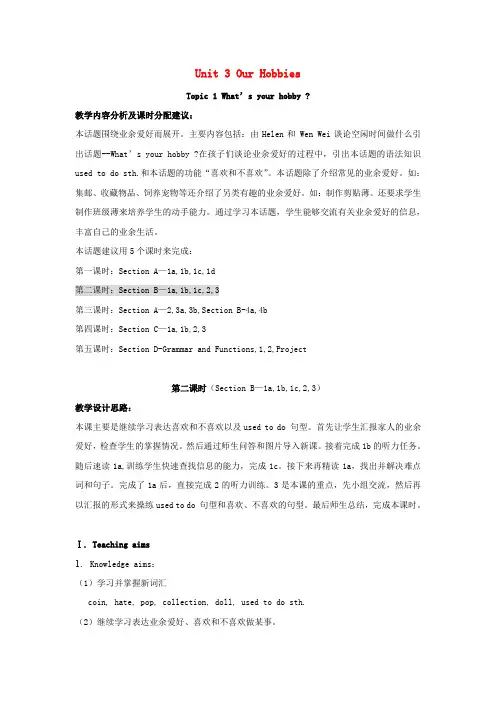
Unit 3 Our HobbiesTopic 1 What’s your hobby ?教学内容分析及课时分配建议:本话题围绕业余爱好而展开。
主要内容包括:由Helen和 Wen Wei谈论空闲时间做什么引出话题--What’s your hobby ?在孩子们谈论业余爱好的过程中,引出本话题的语法知识used to do sth.和本话题的功能“喜欢和不喜欢”。
本话题除了介绍常见的业余爱好。
如:集邮、收藏物品、饲养宠物等还介绍了另类有趣的业余爱好。
如:制作剪贴薄。
还要求学生制作班级薄来培养学生的动手能力。
通过学习本话题,学生能够交流有关业余爱好的信息,丰富自己的业余生活。
本话题建议用5个课时来完成:第一课时:Section A—1a,1b,1c,1d第二课时:Section B—1a,1b,1c,2,3第三课时:Section A—2,3a,3b,Section B-4a,4b第四课时:Section C—1a,1b,2,3第五课时:Section D-Grammar and Functions,1,2,Project第二课时(Section B—1a,1b,1c,2,3)教学设计思路:本课主要是继续学习表达喜欢和不喜欢以及used to do 句型。
首先让学生汇报家人的业余爱好,检查学生的掌握情况。
然后通过师生问答和图片导入新课。
接着完成1b的听力任务。
随后速读1a,训练学生快速查找信息的能力,完成1c。
接下来再精读1a,找出并解决难点词和句子。
完成了1a后,直接完成2的听力训练。
3是本课的重点,先小组交流,然后再以汇报的形式来操练used to do 句型和喜欢、不喜欢的句型。
最后师生总结,完成本课时。
Ⅰ. Teaching aims1.Knowledge aims:(1)学习并掌握新词汇coin, hate, pop, collection, doll, used to do sth.(2)继续学习表达业余爱好、喜欢和不喜欢做某事。
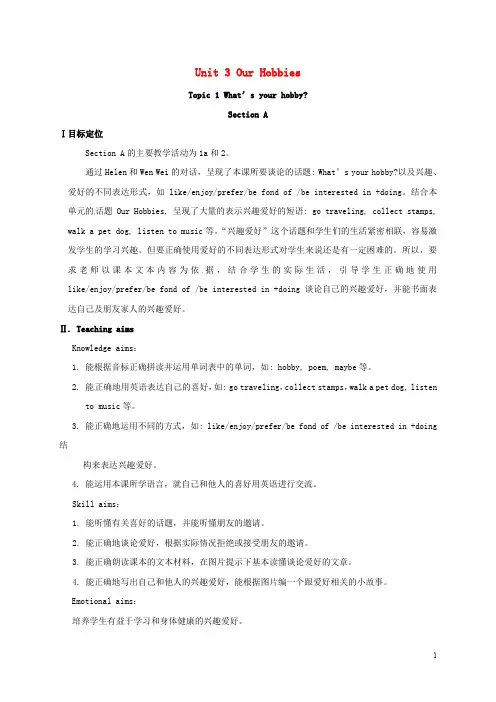
Unit 3 Our HobbiesTopic 1 What’s your hobby?Section AⅠ目标定位Section A的主要教学活动为1a和2。
通过Helen和Wen Wei的对话,呈现了本课所要谈论的话题: What’s your hobby?以及兴趣、爱好的不同表达形式,如like/enjoy/prefer/be fond of /be interested in +doing。
结合本单元的话题Our Hobbies, 呈现了大量的表示兴趣爱好的短语: go traveling, collect stamps, walk a pet dog, listen to music等。
“兴趣爱好”这个话题和学生们的生活紧密相联,容易激发学生的学习兴趣。
但要正确使用爱好的不同表达形式对学生来说还是有一定困难的。
所以,要求老师以课本文本内容为依据,结合学生的实际生活,引导学生正确地使用like/enjoy/prefer/be fond of /be interested in +doing谈论自己的兴趣爱好,并能书面表达自己及朋友家人的兴趣爱好。
Ⅱ. Teaching aimsKnowledge aims:1. 能根据音标正确拼读并运用单词表中的单词,如: hobby, poem, maybe等。
2. 能正确地用英语表达自己的喜好,如: go traveling,collect stamps,walk a pet dog, listento music等。
3. 能正确地运用不同的方式,如: like/enjoy/prefer/be fond of /be interested in +doing 结构来表达兴趣爱好。
4. 能运用本课所学语言,就自己和他人的喜好用英语进行交流。
Skill aims:1. 能听懂有关喜好的话题,并能听懂朋友的邀请。
2. 能正确地谈论爱好,根据实际情况拒绝或接受朋友的邀请。
![[推荐学习]校八年级英语上册《Unit 3 Our Hobbies Topic 1 What’s y](https://uimg.taocdn.com/96f2ad2cb52acfc789ebc964.webp)
What’s your hobbySection B一、学习目标:1、学习used to的四种结构。
2、谈论过去与现在不同的兴趣爱好。
3、进一步引导学生培养广泛的兴趣爱好。
二、学习重点:1、used to结构的肯定和否定形式。
2、表达过去的兴趣爱好的方法。
三、学习难点:1、used to结构的肯定和否定形式。
2、表达过去的兴趣爱好的方法。
一、自学自疑(一)词汇过关I.看第134页P57-58的单词,试拼读,并小组内相互拼读。
II.熟记并默写。
1.硬币2.厌恶3.大众的,通俗的4.玩偶5.收藏品二. 在中划出下列短语并翻译1.not all.2.must be3.learn……fromed to5.great fun6.It certainly is.7.le arn a lot about 8.What beautiful stamps!三. 在文中找到下列句子并翻译总结1.I used to collect baseball cards.But now I’m interested in basketball. 译:_______________________used to意为“过去常常”,表示过去的习惯动作或存在的状态,而这种情况现在已不存在。
to为不定式符号。
used to的结构如下:(1)肯定句:主语+used to+动词原形+其它。
汉译英:康康过去喜欢打篮球,现在喜欢踢足球________________________________ (2)否定句:○1主语+didn’t+use to+动词原形+其它○2主语+usedn’t to+动词原形+其它e.g.I didn’t use to go swimming.= _______________________(3)一般疑问句:○1Did+主语+ use to +动词原形+其它○2Used+主语+to+动词原形+其它.e.g.----Did you use to go swimming?----Yes,I did./NO,I didn’t.----Used your father to smoke? ----Yes,he,used./No.he usedn’t.(4)特殊疑问句:○1疑问词+did+主语+use to+动词原形+其它○2疑问词+used+主语+ to+动词原形+其它e.g.What sports did you use to play?= ________________________________拓展:be used to 意为“习惯于做某事”。
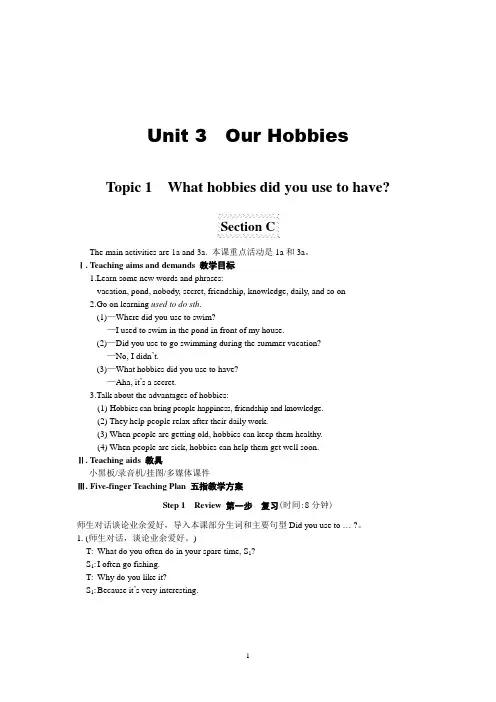
Unit 3 Our Hobbies Topic 1 What hobbies did you use to have?Section CThe main activities are 1a and 3a. 本课重点活动是1a和3a。
Ⅰ. Teaching aims and demands 教学目标1.Learn some new words and phrases:vacation, pond, nobody, secret, friendship, knowledge, daily, and so on2.Go on learning used to do sth.(1)—Where did you use to swim?—I used to swim in the pond in front of my house.(2)—Did you use to go swimming during the summer vacation?—No, I didn’t.(3)—What hobbies did you use to have?—Aha, it’s a secret.3.Talk about the advantages of hobbies:(1) Hobbies can bring people happiness, friendship and knowledge.(2) They help people relax after their daily work.(3) When people are getting old, hobbies can keep them healthy.(4) When people are sick, hobbies can help them get well soon.Ⅱ. Teaching aids 教具小黑板/录音机/挂图/多媒体课件Ⅲ. Five-finger Teaching Plan 五指教学方案Step 1 Review 第一步复习(时间:8分钟)师生对话谈论业余爱好,导入本课部分生词和主要句型Did you use to … ?。
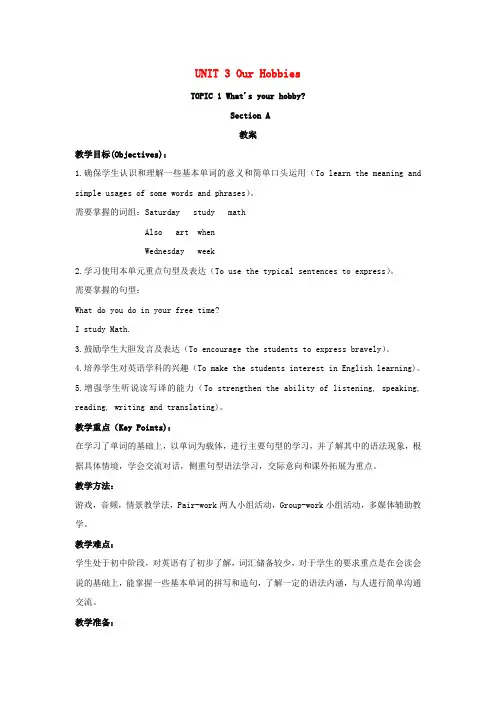
UNIT 3 Our HobbiesTOPIC 1 What's your hobby?Section A教案教学目标(Objectives):1.确保学生认识和理解一些基本单词的意义和简单口头运用(To learn the meaning and simple usages of some words and phrases)。
需要掌握的词组:Saturday study mathAlso art whenWednesday week2.学习使用本单元重点句型及表达(To use the typical sentences to express)。
需要掌握的句型:What do you do in your free time?I study Math.3.鼓励学生大胆发言及表达(To encourage the students to express bravely)。
4.培养学生对英语学科的兴趣(To make the students interest in English learning)。
5.增强学生听说读写译的能力(To strengthen the ability of listening, speaking, reading, writing and translating)。
教学重点(Key Points):在学习了单词的基础上,以单词为载体,进行主要句型的学习,并了解其中的语法现象,根据具体情境,学会交流对话,侧重句型语法学习,交际意向和课外拓展为重点。
教学方法:游戏,音频,情景教学法,Pair-work两人小组活动,Group-work小组活动,多媒体辅助教学。
教学难点:学生处于初中阶段,对英语有了初步了解,词汇储备较少,对于学生的要求重点是在会读会说的基础上,能掌握一些基本单词的拼写和造句,了解一定的语法内涵,与人进行简单沟通交流。
教学准备:课件、照片素材、音频文件、教学道具。
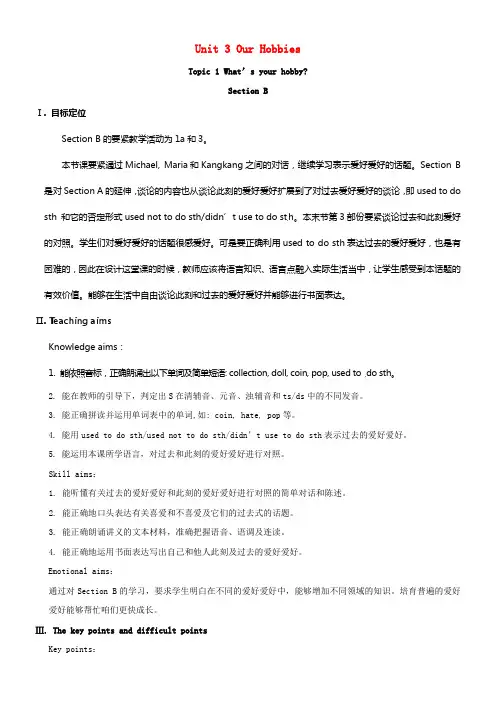
Unit 3 Our HobbiesTopic 1 What’s your hobby?Section BⅠ. 目标定位Section B的要紧教学活动为1a和3。
本节课要紧通过Michael, Maria和Kangkang之间的对话,继续学习表示爱好爱好的话题。
Section B 是对Section A的延伸,谈论的内容也从谈论此刻的爱好爱好扩展到了对过去爱好爱好的谈论,即used to do sth 和它的否定形式used not to do sth/didn’t use to do st h。
本末节第3部份要紧谈论过去和此刻爱好的对照。
学生们对爱好爱好的话题很感爱好。
可是要正确利用used to do sth表达过去的爱好爱好,也是有困难的,因此在设计这堂课的时候,教师应该将语言知识、语言点融入实际生活当中,让学生感受到本话题的有效价值。
能够在生活中自由谈论此刻和过去的爱好爱好并能够进行书面表达。
Ⅱ. Teaching aimsKnowledge aims:1. 能依照音标,正确朗诵出以下单词及简单短语: collection, doll, coin, pop, used to do sth。
2. 能在教师的引导下,判定出S在清辅音、元音、浊辅音和ts/ds中的不同发音。
3. 能正确拼读并运用单词表中的单词,如: coin, hate, pop等。
4. 能用used to do sth/used not to do sth/didn’t use to do sth表示过去的爱好爱好。
5. 能运用本课所学语言,对过去和此刻的爱好爱好进行对照。
Skill aims:1. 能听懂有关过去的爱好爱好和此刻的爱好爱好进行对照的简单对话和陈述。
2. 能正确地口头表达有关喜爱和不喜爱及它们的过去式的话题。
3. 能正确朗诵讲义的文本材料,准确把握语音、语调及连读。
4. 能正确地运用书面表达写出自己和他人此刻及过去的爱好爱好。
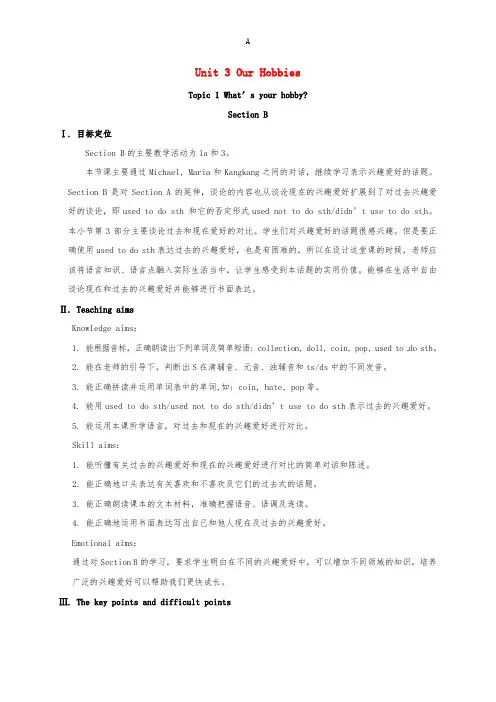
Unit 3 Our HobbiesTopic 1 What’s your hobby?Section BⅠ. 目标定位Section B的主要教学活动为1a和3。
本节课主要通过Michael, Maria和Kangkang之间的对话,继续学习表示兴趣爱好的话题。
Section B是对Section A的延伸,谈论的内容也从谈论现在的兴趣爱好扩展到了对过去兴趣爱好的谈论,即used to do sth 和它的否定形式used not to do sth/didn’t use to do st h。
本小节第3部分主要谈论过去和现在爱好的对比。
学生们对兴趣爱好的话题很感兴趣。
但是要正确使用used to do sth表达过去的兴趣爱好,也是有困难的,所以在设计这堂课的时候,老师应该将语言知识、语言点融入实际生活当中,让学生感受到本话题的实用价值。
能够在生活中自由谈论现在和过去的兴趣爱好并能够进行书面表达。
Ⅱ. Teaching aimsKnowledge aims:1. 能根据音标,正确朗读出下列单词及简单短语: collection, doll, coin, pop, used to do sth。
2. 能在老师的引导下,判断出S在清辅音、元音、浊辅音和ts/ds中的不同发音。
3. 能正确拼读并运用单词表中的单词,如: coin, hate, pop等。
4. 能用used to do sth/used not to do sth/didn’t use to do sth表示过去的兴趣爱好。
5. 能运用本课所学语言,对过去和现在的兴趣爱好进行对比。
Skill aims:1. 能听懂有关过去的兴趣爱好和现在的兴趣爱好进行对比的简单对话和陈述。
2. 能正确地口头表达有关喜欢和不喜欢及它们的过去式的话题。
3. 能正确朗读课本的文本材料,准确把握语音、语调及连读。
4. 能正确地运用书面表达写出自己和他人现在及过去的兴趣爱好。
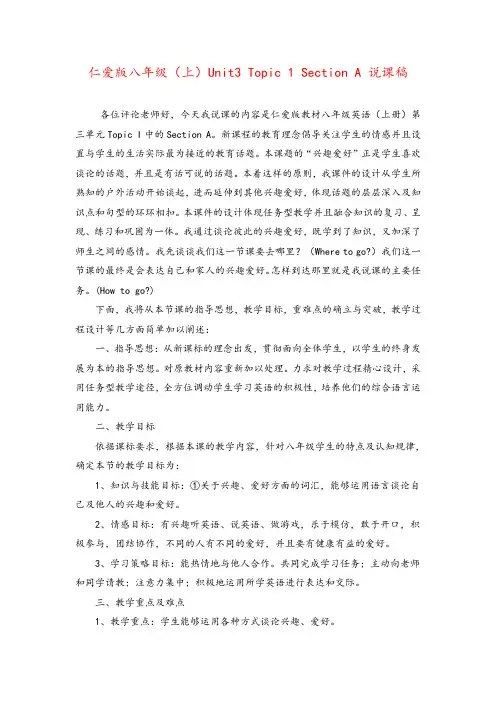
仁爱版八年级(上)Unit3 Topic 1 Section A 说课稿各位评论老师好,今天我说课的内容是仁爱版教材八年级英语(上册)第三单元Topic I中的Section A。
新课程的教育理念倡导关注学生的情感并且设置与学生的生活实际最为接近的教育话题。
本课题的“兴趣爱好”正是学生喜欢谈论的话题,并且是有话可说的话题。
本着这样的原则,我课件的设计从学生所熟知的户外活动开始谈起,进而延伸到其他兴趣爱好,体现话题的层层深入及知识点和句型的环环相扣。
本课件的设计体现任务型教学并且融合知识的复习、呈现、练习和巩固为一体。
我通过谈论彼此的兴趣爱好,既学到了知识,又加深了师生之间的感情。
我先谈谈我们这一节课要去哪里?(Where to go?)我们这一节课的最终是会表达自己和家人的兴趣爱好。
怎样到达那里就是我说课的主要任务。
(How to go?)下面,我将从本节课的指导思想,教学目标,重难点的确立与突破,教学过程设计等几方面简单加以阐述:一、指导思想:从新课标的理念出发,贯彻面向全体学生,以学生的终身发展为本的指导思想。
对原教材内容重新加以处理。
力求对教学过程精心设计,采用任务型教学途径,全方位调动学生学习英语的积极性,培养他们的综合语言运用能力。
二、教学目标依据课标要求,根据本课的教学内容,针对八年级学生的特点及认知规律,确定本节的教学目标为:1、知识与技能目标:①关于兴趣、爱好方面的词汇,能够运用语言谈论自己及他人的兴趣和爱好。
2、情感目标:有兴趣听英语、说英语、做游戏,乐于模仿,敢于开口,积极参与,团结协作,不同的人有不同的爱好,并且要有健康有益的爱好。
3、学习策略目标:能热情地与他人合作。
共同完成学习任务;主动向老师和同学请教;注意力集中;积极地运用所学英语进行表达和交际。
三、教学重点及难点1、教学重点:学生能够运用各种方式谈论兴趣、爱好。
2、教学难点:be interested in,be fond of的用法四、教学过程1、课前热身,听一首歌:(调动学生的积极性,拉近师生的距离)(热身)My heart will go on.还有一个原因就是在Unit3Topic2SectionB中,要问到,同学听过这首歌吗?为下周的学习打下基础。
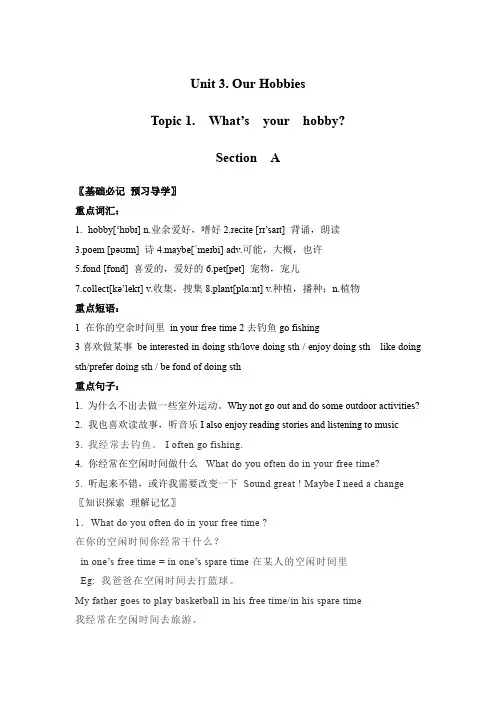
Unit 3. Our HobbiesTopic 1. What’s your hobby?Section A〖基础必记预习导学〗重点词汇:1.hobby[‘hɒbɪ] n.业余爱好,嗜好2.recite [rɪ’saɪt] 背诵,朗读3.poem [pəʊɪm] 诗4.maybe[ˈmeɪbi] adv.可能,大概,也许5.fond [fɒnd] 喜爱的,爱好的6.pet[pet] 宠物,宠儿7.collect[kə’lekt] v.收集,搜集8.plant[plɑ:nt] v.种植,播种;n.植物重点短语:1 在你的空余时间里in your free time 2去钓鱼go fishing3喜欢做某事be interested in doing sth/love doing sth / enjoy doing sth like doing sth/prefer doing sth / be fond of doing sth重点句子:1. 为什么不出去做一些室外运动。
Why not go out and do some outdoor activities?2.我也喜欢读故事,听音乐I also enjoy reading stories and listening to music3.我经常去钓鱼。
I often go fishing.4.你经常在空闲时间做什么What do you often do in your free time?5.听起来不错,或许我需要改变一下Sound great !Maybe I need a change 〖知识探索理解记忆〗1.What do you often do in your free time ?在你的空闲时间你经常干什么?in one’s free time = in one’s spare time在某人的空闲时间里Eg: 我爸爸在空闲时间去打篮球。
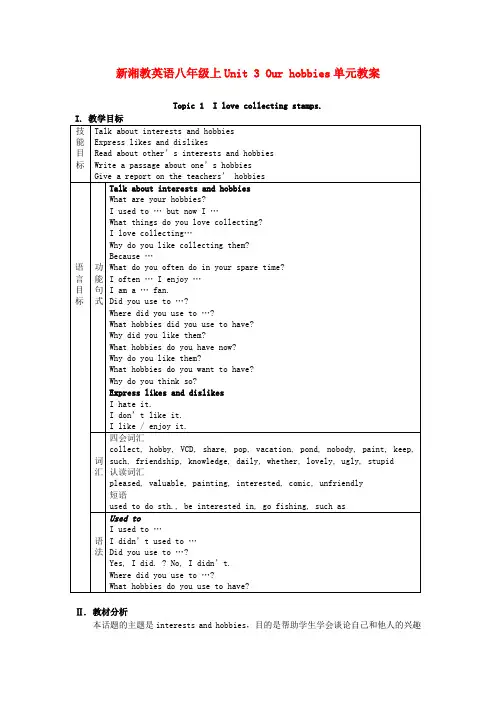
新湘教英语八年级上Unit 3 Our hobbies单元教案Topic 1 I love collecting stamps.Ⅱ. 教材分析本话题的主题是interests and hobbies,目的是帮助学生学会谈论自己和他人的兴趣和爱好、表达喜欢和不喜欢的事。
学习Used to结构来谈论过去的兴趣和爱好。
在学习语言知识的同时,引导学生进行一些积极的课外活动。
Section A 1a用一个对话引出主题,也是目标语言的初步呈现;1b 学生看图选择自己喜欢的东西,为后面的1c会话做了语言上的铺垫;1c是口头练习,谈论喜欢收集什么以及为什么喜欢;2a和2b是就兴趣爱好的不同表达法的听说练习,包括love, be interested in, enjoy, prefer 等结构,同时学习一些表兴趣和爱好的动词及动词短语。
Section B 1a和1b掌握对现在的兴趣和爱好的提问及回答;2a、2b 和3学习用used to do sth 句型表达过去的兴趣和爱好,形式为阅读理解和小组活动。
Section C 1a、1b 和2继续就used to do sth 句型展开一般疑问句和特殊疑问句的问答练习,描述自己和他人过去的兴趣爱好;3a和3b是阅读理解练习,了解兴趣爱好给人们带来的益处,并就一些重点词汇进行填空练习。
Section D围绕养宠物这一爱好展开,1a 和1b是听、读和说的练习;2是写作练习,就自己的爱好根据提示问题写一段文章,描述自己过去、现在以及将来的爱好并说明原因;3a和3b是本话题语法和一些表达法的总结归纳;4是一个课题活动,内容是对所有的代课教师的爱好做一调查,并向班内同学做报告,是对目标语言的综合运用和检验。
Ⅲ. 分课时教案Section ATarget languagea.key words and phrasespleased, collect, valuable, hobby, painting, be interested in, used to …, enjoy doing, prefer doing, collect stampsb.key sentencesWhat are your hobbies?I used to … but now I …What things do you love collecting?I love collecting…Why do you like collecting them?Because …Ability goalsEnable students to talk about what they love doing and why.Teaching aidsTape recorderTeaching procedures and waysStep 1 Lead-inThe teacher introduces the usage of verbs phrases: love doing, enjoy doing, like doing, prefer doingTalk to students about the things they like doing.T: I love shopping. I go to the supermarket for shopping almost every weekend. What about you? What do you love doing?S1: I love reading.T: What do you like doing?S2: I like swimming.T: What do you enjoy doing?S3: I enjoy running.T: What do you prefer doing?S4: I prefer …Learn the new words “hobby, collect, paining, valuable, rock music” etc.Step 2 New function introductionPresent “pleased to do, must be, used to do, be interested in”. Write examples on the blackboard(1)Pleased to see you / Glad to see you / Happy to see you / Nice to see you.(2)He isn’t in the bedroom. He must be in the study.(3)I used to listen to rock music, but now I don’t like it.He used to play computer games on Sunday, but now he often does homework.(4)He didn’t used to drink milk.He usedn’t to drink milk.(5)Did he use to live in Bejing?Used he to live in Beijing?(6)be used to (doing) sth.My father is used to working hard/hard work.(7) I’m not really interested in maths.The teacher gives a simple introduction of exclamation.What + a / an + adj. + nHow + adj. / adv.Use the pictures in 1b to make exclamation sentences with “What / How.”Example: What an interesting story book (it is)!How interesting the story book is!Step 3 ListeningListen to the tape of 1a and repeat after the tape. Then answer questions: What’s Maria’s hobby?What’s Michael’s hobby?Why does Maria love collecting stamps?What does Maria lean from the stamps?Pair wok in 1c.Help students choose the things they love collecting from 1b.Make dialog like this:S1: Do you love collecting coins?S2: No, I don’t.S1: What things do you love collecting?S2: I love collecting story books.S1: Why do you like collecting them?S2: Because it gives me great joy.Step 4 PracticeT: Now let’s practice “be interested in.” (Write “be interested in” on the Bb”.)Write the following on the Bb.Is he /she interested in …?Yes, he / she is.No, he / she isn’t.What’s he / she interested in?He / She is interested in …?Help students ask similar questions with the pictures of 1b.Are you interesting in “photos of famous stars / model planes / collecting coins?”No, I’m not.What are you interested in?I interested in …Step 5 Match workDeal with activity 2b.First go through the verb phrases with students.T: Now listen to the tape carefully. Then match the phrases with the pictures. Check the answers.The let students work in pairs to make conversations about what these people like doing.Note:walk a pet dog=take a pet dog for a walkwater flowers: water is used as verb hereStep 6 HomeworkAfter class, make a list of the hobbies you have learned in this period and check which you like to keep and which you don’t.Section BTarget languagea . key words and phrasescoins, share, pop, outdoor activity, go out to do, why not do …, all the time, need a changeb . key sentencesWhat do you often do in your spare time?I often rent VCDs and watch them at home.Why not go out do some outdoor activities?Maybe I need a change.Ability goalsEnable students to make a survey about their classmates’ hobbies.Enable students to talk about their past and present hobbies.Read and understand other’s interests and hobbies.Teaching aidsTape recorder, projectorTeaching procedures and waysStep 1 RevisionReview the expressions to talk about hobbiesT: Jenny enjoys cooking. Cooking is her hobby. Well, what’s Peter’s hobby? Ss: Traveling.T: Yes, Peter love traveling. So what’s Sally’s hobby?Ss: Reading novels.T: What’s Michael’s hobby?Ss: Reading comics.Note:“comic”comic strip / book 连环漫画册comic opera 喜歌剧a comic writer 喜剧作家“spare”spare time 业余时间 have no time to spare 抽不出时间Example: What do you often do in your spare time?He said he could spare me half an hour.Step 2 New function introductionListen to the tape and read 1a following the tape. Then answer the questions: What does Wen Wei often do in his spare time?What’s Hellen’s hobby?Summarize different ways to ask about hobbies:What do you often do in your spare time?What’s your hobby?What are you interested in?What things do you love colleting?Then explain the following language points:1) go out for / go out to do …I like going out for a walk with mother.Let’s go out to play basketball.2) Why not do …? = Why don’t you do …?Why not see a movie. = Why don’t you see a movie?3) interests = bobbies 业余爱好He is a man of wide interests.4) places of interest 名胜There are many places of interest in Beijing.5) with interest 带着兴趣We should learn English with interest.6) feel / take / have / show interest in …对……感兴趣lose interest in …对……失去兴趣Step 3 ReadingThis step provides reading practice with the target language.First get students read the passage and tell what the passage mainly talks about. Main idea of the passage: Philip’s present and past interestsThen let them complete the chart in activity 2b.Check the answers. Then ask students,T: Do you share his interests? (It means if you have the same interests as him.) Ss: …Key expressions:used to be … / used to do …all the time 一直/始终not at all 一点也不miss …错过……know a little / much about …对……了解一些/很多Get students to make sentences with these expressions.Step 4 PracticeWork in groups, practice activity 3.Summarize how to express likes and dislikes:(don’t) like / enjoy …hate …prefer doing …Show the form to the class and let them practice it in pairs.e.g.I used to … but now I hate it. Now I enjoy …I used to … but now I don’t like /enjoy it. I prefer …Step 5 SummaryReview the use of “used to”Review how to express interest and hobbies with “enjoy, like, love, prefer, be interested in”Section CTarget languagea. key words and expressionsvacation, nobody, keep, knowledge, dailyb. key sentencesWhat hobbies did you use to have?What hobbies do you have now?Did you use to …?Where did you use to …?Hobbies help people relax … hobbies can keep them healthy … hobbies can help them …Ability goalsEnable students to ask and answer general and special questions with “use to”. Enable students to understand the benefits of hobbies through reading.Teaching aidsTape recorder, projectorTeaching procedures and waysStep 1 RevisionFirst help students review the structures they have learned in last period. Make casual conversations, using the pattern of “used to do”.T: I used to read books. Did you use to read books?S: Yes, I did.T: What books did you use to read?S: I used to read cartoon books.T: When did you used to read them?Ss: I used to red them on Sundays.Step 2 Function presentationPlay the tape of 1a. Emphasize on the sentences patterns:Did you use to …?Where did you …?Key expressions:★teach oneself / teach sb. sth./ teach sb. to do sth.★summer vacation / winter vacation (vacation= holiday)★in front of★How clever! (exclamation, more example in Topic 2)Conduct a dialog with a student as following:T: What did you used to do during the summer vacation?S: I used to learn physics.T: Where did you used to learn physics?S: I used to learn it at home.T: Did your teacher teach you?S: No, I taught myself.Let students practice the conversation in 1a.Words:1. during prep , 在……期间1) I often went to see her during my stay there.2) 比较 in & during 表示“(在时间段)内”时,in可与during互换These animals never go out the hole during / in winter.3) during 不与具体数字长度连用,而用forI lived in Los Angeles for five years.2. nobody = not anybodyThere is nobody in the room. = There isn’t anybody in the room.3. keep pets 养宠物4. dance to 伴着……跳舞The children are dancing to the beautiful songs happily.Step 3 PracticeThis step provides practice with the hobbies one had in the past and the hobbies one have now.(1b) Practice the conversation in 1b with a student.T: What hobbies did you use to have two years ago?S: I used to …T: What hobbies do you have now?S: Now, I …T: Now work in pairs and make similar conversations with the phrases in the chart. Ss: …(2)Then ask students’ different hobbies in four seasons.T: Kangkang and Michael are good friends. They love playing together. Look at the pictures in activity 2. These pictures tell about their past hobbies in the four seasons. Complete the sentences using used to.Then the teacher can write down “spring, summer, fall, winter” on the Bb as four headings, and letSs write down their childhood activities under each heading. Then get some students give an oralreport of their activities in four seasons.Step 4 ReadingThis step provides reading practice with the target language.First ask students to read the passage and tell the main idea of each paragraph. Para 1: People’s hobbiesPara 2: Why people have hobbiesThen let students underline the key words and phrases in para. 2 that explain the benefits of hobbies.Key words and phrases:bring happiness, friendship and knowledge; help people relax; keep people healthy; help people get wellActivity 3b provides practice with some key words.Let students complete the passage with suitable words. Check the answers.Step 5 HomeworkEnd the class by chanting (4) together.T: After class, write a short passage about your hobbies or how you spend your spare time in the four seasons.Section DTarget languagea. key words and expressionswhether, unfriendly, lovely, ugly, stupidb. Key sentencesDifferent people have different hobbies.He doesn’t mind whether they are good or not.What hobbies do you want to have?Ability goalsEnable students to write a passage about their hobbies.Review the use of “used to …” and the useful expressionsTeaching aidsTape recorder, some cardsTeaching procedures and waysStep 1 Listening and speakingThis step provides listening and oral practice about keeping pets.First introduce the word “pet”.T: What is pet? (…) People keep pets in their houses such as cat, dog, fish, bird etc. Do you understand? Do you have any pet in your house? What is it?Ss: …T: Do you like pig? How about a pet pig?Listen to the tape and complete 1a.Listen again and check the answers.Then let students answer the questions:1)What is the speaker’s pet?2)What does the pig look like?4) What does the pig like to eat?5) How does he take care of the pig?Explain:1) keep pet 养宠物2) take a bath 洗澡3) whether … or not 不管……还是……4) take … for a walk 带……去散步He does mind whether they’re good or not.Whether he succeeds or fails, he is the best.I don’t know whether he will come or not.Finally ask,T: Do you like to keep such a pet pig in your house? Why or why not?Ss: …T: What adjectives would you use to describe pigs?Ss: Dirty, lovely, fat …T: Look at the words in the box in 1b. Let’s read them.Make sure students know the meanings of the words. (Ask students to tell which words have the opposite meanings like dirty→clean.)Then let students discuss the questions in groups, using the words.Step 2 WritingWrite a short passage about your hobbies according to the question above.T: Different people have different hobbies. And a person may have different hobbies during different seasons or in different time. We know how to talk about past and present hobbies. What about future hobbies?Introduce the sentence patterns:- What hobbies do you want to have?- I want to …- Why do you think so?- Because …Then let students write a short passage about their hobbies according to the questions.Step 3 Project (Homework)T: Do you want to know what your teachers are interested in?Ss: Yes.T: Why not make a survey? Look at the chart in activity 4. Ask your teachers about their past and present hobbies and the reasons why they like / liked them. Do it after class and complete the chart.In the next period, ask some students to report their survey results to the class like this:My head teacher is …, he used to play guitar. But now he enjoys playing basketball, because itcan keep him healthy. …Topic 2 It sounds great!I. 教学目标Section A 1a 和1b围绕音乐会,用be going to结构进行会话练习;2a、 2b和 2c 以乐器为话题,学习一些乐器名称并结对谈论乐器,最后阅读一段相关文章。
Unit 3 Our HobbiesTopic 1 What hobbies did you use to have?Section AThe main activities are 1a and 2a. 本课重点活动是1a 和2a 。
Ⅰ.Teaching aims and demands 教学目标1. Learn some useful words and expressions:collect, hobby, used to do sth., stone, coin, act2. Use “prefer, like, love, enjoy, be interested in, be fond of”to express likes and dislikes:(1) I prefer playing soccer.(2) I like reciting poems.(3) I love singing and playing the guitar.(4) I enjoy dancing to music.(5) I am interested in playing basketball.(6) I am fond of acting.3. Talk about interests and hobbies:(1)—What are your hobbies?—I used to enjoy listening to rock music, but now I love collecting paintings andtelephone cards.(2)—What do you love collecting?—I love collecting stones/coins/…—Why do you like collecting them?—Because they are very beautiful./…Ⅱ. Teaching aids 教具录音机/图画/挂图/集邮册Ⅲ. Five -finger Teaching Plan 五指教学方案Step 1 Review 第一步 复习(时间:10分钟)1. (师生对话,谈论自己喜欢做的事情,引出本课的重点句型和词汇。
Unit 3 Our HobbiesTopic 1 What’s your hobby?Section D教学设计内容仁爱版八年级上设计主题Unit3 Topic 1 What’s your hobby? Section D1.教学背景分析(1)教学内容分析:该部分是本话题的最后一课时。
主要活动为Grammar、Functions的小结和1。
要求教师通过设计不同形式的活动来引导学生自己总结整个话题的语法used to do sth和表示兴趣爱好的功能句I enjoy/like/prefer/be fond of /be interested in+doing。
并通过文本阅读来提升学生的综合应用能力。
(2)学生情况分析:初二七班是初二年分层走班后的A班,学生整体层次较高,基础比较扎实,因此课堂整体以自主学习为主,教师主体起辅助作用。
2.教学目标分析1.Teaching Aims(教学目标)1. Knowledge & Skill aims(知识与技能目标)1.能归纳总结关于爱好的相关短语;2. 能熟练谈论表示兴趣爱好的话题;3. 能阅读相关文本并准确提取信息。
2. Process & Method aims(过程与方法)任务型教学,小组讨论,听说读写看结合3.Emotional, attitude & value aims(情感,态度与价值观)1. 初步感受、协调在和小组合作的时候的独立性和集体主义。
2. 学会拓展学习资源,帮助自己提升学习能力3.教学重点、难点分析教学重点1. 复习关于hobby的相关短语。
2. 巩固enjoy/like/prefer/be fond of /be interested in+doing的应用。
教学难点:学会简单列出话题小作文的基本导图4.教学过程设计Step 1 Introduction(情境导入)(3 mins)1.According to the picture ,guess what is ……hobby?2.Watch video and talk teacher’s hobby.(设计意图:复习并应用前面所学知识,以老师的实例引发学生兴趣)Step 2 Group Work(小组研学)(15 mins)。
八年级上册教案设计
Unit 3 Our Hobbies
Topic 1 What’s your hobby?
Section A
Ⅰ. Material analysis
Section A的主要教学活动为1a和2。
通过Helen和Wen Wei的对话,呈现了本课所要谈论的话题: What’s your hobby?以及兴趣、爱好的不同表达形式,如like/enjoy/prefer/be fond of /be interested in +doing。
结合本单元的话题Our Hobbies, 呈现了大量的表示兴趣爱好的短语: go traveling, collect stamps, walk a pet dog, listen to music等。
“兴趣爱好”这个话题和学生们的生活紧密相联,容易激发学生的学习兴趣。
但要正确使用爱好的不同表达形式对学生来说还是有一定困难的。
所以,要求老师以课本文本内容为依据,结合学生的实际生活,引导学生正确地使用like/enjoy/prefer/be fond of /be interested in +doing谈论自己的兴趣爱好,并能书面表达自己及朋友家人的兴趣爱好。
Ⅱ. Teaching aims
Knowledge aims:
1. 能根据音标正确拼读并运用单词表中的单词,如: hobby, poem, maybe等。
2. 能正确地用英语表达自己的喜好,如: go traveling,collect stamps,walk a pet dog, listen
to music等。
3. 能正确地运用不同的方式,如: like/enjoy/prefer/be fond of /be interested in +doing结
构来表达兴趣爱好。
4. 能运用本课所学语言,就自己和他人的喜好用英语进行交流。
Skill aims:
1. 能听懂有关喜好的话题,并能听懂朋友的邀请。
2. 能正确地谈论爱好,根据实际情况拒绝或接受朋友的邀请。
3. 能正确朗读课本的文本材料,在图片提示下基本读懂谈论爱好的文章。
4. 能正确地写出自己和他人的兴趣爱好,能根据图片编一个跟爱好相关的小故事。
Emotional aims:
培养学生有益于学习和身体健康的兴趣爱好。
Ⅲ. The key points and difficult points
Key points:
1. What’s your hobby? My hobby is...及like/enjoy/prefer/be fond of /be interested in +doing
句型。
2. go traveling, collect stamps, walk a pet dog, listen to music
Difficult points:
be fond of/be interested in其后动词要用V-ing形式。
Ⅳ. Learning strategies
1.学生能够借助不同的句型和句子结构来表达相同的意思,这样有助于口语和书面表达的
灵活性和多样性。
2.听前复习词组,扫除词汇障碍,对完成听力任务有很大的帮助。
Ⅴ. Teaching aids
Computer multimedia projector
Ⅵ. Teaching procedures
Ⅶ. Blackboard design。